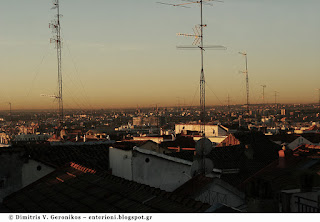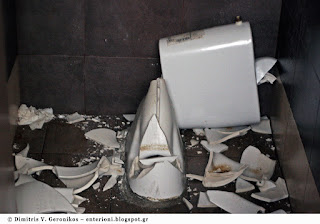Η επιστροφή στη Μαδρίτη μετά από αρκετά χρόνια, αφήνει μια αίσθηση μεταφοράς στο χωροχρόνο. Η μελωδία, το άρωμα, η ανάσα, η γαστρονομία, το θρόϊσμα των πλατανιών, οι στίχοι του Λόρκα, το φλαμένκο στις μαδριλένικες σάλες, το χιλιόμετρο μηδέν, o έρωτας που μπορείς να νοιώσεις στην καστιλιάνικη μητρόπολη και πολλά άλλα συνθέτουν χαρακτηριστικά της Μαδριλένικης ζωής. Η πρωτεύουσα της Ισπανίας αποτελεί το μεγαλύτερο αστικό σύνολο της Ιβηρικής χερσονήσου. Γεωγραφικά εκτείνεται στο κέντρο σχεδόν της ηπειρωτικής χώρας, στο υψίπεδο της Νέας Καστίλης και σε υψόμετρο 635 μ. από τη στάθμη της θάλασσας.
Η
μαυριτάνικη ονομασία της πόλης (Ματζρίτ)
αποτελεί το πρώτο ιστορικό στοιχείο
για την ύπαρξή της. Μνημονεύεται μάλλον
το 932 μ.Χ. όταν ο Ραμίρο Β' ισοπέδωσε τα
τείχη της αλλά την άφησε σε μαυριτάνικα
χέρια. Ίχνη ρωμαϊκού οικισμού και
ορισμένες ενδείξεις προϊστορικής
ανθρώπινης παρουσίας, έχουν βρεθεί στην
περιοχή. Το μαυριτάνικο φρούριο
καταλήφθηκε το 1803 από τους χριστιανούς
υπό τον Αλφόνσο ΣΤ' της Καστίλης και
Λεόν. Εκεί
συνήλθε
για
πρώτη
φορά
το
Κοινοβούλιο
(Κόρτες),
το
1329.
Επί αιώνες, η πόλη ήταν συγκεντρωμένη γύρω από τα ανάκτορα, ενώ αργότερα άρχισε να επεκτείνεται προς τα ανατολικά. Η επέκτασή της προς τα δυτικά, πέρα από τον ποταμό Μανθανάρες, έγινε μετά το 1948 και υπήρξε εκρηκτική. Από το 1948 ως το 1951, η συνολική της έκταση δεκαπλασιάστηκε και έφθασε τα 531 τετραγωνικά χιλιόμετρα. Σήμερα σύμφωνα με την καταμέτρηση του ισπανικού ινστιτούτου στατιστικής καταλαμβάνει 604,45 τ. χλμ. και κατοικείται από 3.182.981 ανθρώπους.
Είναι μία
μητρόπολη που επηρεάστηκε δραματικά
από τους πολέμους τους προηγούμενου
αιώνα, ωστόσο τη δυστυχία του πολέμου
οι ισπανοί καλλιτέχνες τη μετέτρεψαν
σε ποίηση και πεζογραφία, ζωγραφική και
κινηματογράφο, μουσική και φωτογραφία.
Λίγα
χρόνια μετά τη στυγνή δικτατορία του
στρατηγού Φρανθίσκο Φράνκο, γεννήθηκε
το πολιτισμικό ρεύμα Μοβίδα Μαδριλένια
μεταξύ 1977-78 στην ισπανική πρωτεύουσα.
Αφετηρία του ήταν οι μπάντες της πρώτης
πανκ σκηνής και του νέου Μαδριλένικου
κύμματος. Ένα πολιτισμικό ρεύμα που
είχε σημαντική επιρροή απ' όσα συνέβαιναν
σε αρκετές αγγλόφωμες πόλεις (Λονδίνο,
Νέα Υόρκη, Λος Άντζελες) τις ίδιες μέρες.1
Ήταν η χρονική περίοδος της
μετάβασης σε δημοκρατικό πολίτευμα με
το πρώτο Σύνταγμα που προέβλεπε
βασιλευόμενη κοινοβουλευτική δημοκρατία
και διαχωρισμό της Εκκλησίας
από το Κράτος.
H
Movida άφησε μια τεράστια πολιτιστική
κληρονομιά, δεδομένου του καινοτόμου,
ελευθεριακού και σύγχρονου χαρακτήρα
της, που ήξερε πώς να σπάει τον παραδοσιακό
χαρακτήρα της φραγκοκρατικής κοινωνίας.
Οι κυριότεροι πυρήνες της movida ήταν η
ίδια η πρωτεύουσα η Μαδρίτη, η Βαρκελώνη, το
Μπιλμπάο, Torremolinos (Μάλαγα και Κόστα
ντελ Σολ), η Βαλένθια και το Βίγο.
Εκείνα
τα χρόνια των '80s, λαμβάνει χώρα η
αποποινικοποίηση της ομοφυλοφιλίας, η
γέννηση της σεξουαλικής επανάστασης,
η αναζοωγόνηση του φεμινιστικού
κινήματος, αλλά και η έξαρση της χρήσης
ναρκωτικών ουσιών.
Πολλές
φορές τότε, από την έλλειψη γνώσης κι
εμπειρίας γύρω από τις παρενέργειες
ουσιών όπως η ηρωίνη, προκλήθηκαν θάνατοι
χιλιάδων ανθρώπων προερχόμενων από
διάφορες κοινωνικές τάξεις και σημαντικών
καλλιτεχνών της μουσικής, του κινηματογράφου
και του θεάτρου. Ολόκληρες οικογένειες
ξεκληρίστηκαν και πολλές γειτονιές
θρήνησαν άπειρα θύματα στο βωμό της
προαναφερόμενης ουσίας.
Το γεγονός αυτό
λειτούργησε καθοριστικά για την αλλαγή
πολιτικής περί ναρκωτικών, καθώς οι
Ισπανοί έγκαιρα κατάλαβαν ότι η σύγχυση
ουσιών σε κοινωνικό επίπεδο μόνο τραγικά
αποτελέσματα φέρνει, αφού ουσιαστικά
εξυπηρετεί τα συμφέροντα των ναρκο-εμπόρων.
Τα πάρκα, τα
άλση και οι φυτευμένοι δρόμοι με πλατάνια
μέσα στις συνοικίες της ισπανικής
πρωτεύουσας, εξ' αρχής ενθουσιάζουν με
την παρουσία και φυτοϋγεία τους, καθώς
αποδύκνειουν έμπρακτα τον έρωτα των
Μαδριλένιων για τα δένδρα. Η δημοτική
αρχή της ισπανικής πρωτεύουσας δίνει
προτεραιότητα στην αντιμετώπιση της
κλιματικής αλλαγής, οπότε προσέχει
ιδιαίτερα τη φροντίδα των δένδρων και
τη δημιουργία νέων ζωνών πρασίνου υψηλής
βλάστησης με ελεύθερες εκτάσεις γης.
Προσγειώθηκα για πρώτη φορά στο Μπαράχας, στο αεροδρόμιο της Μαδρίτης, το Δεκέμβριο του 1999. Οι αρχικές δυνατές εντυπώσεις από τις πρώτες εικόνες της πόλης, αφορούσαν στο κόκκινο χρώμα του ηλιοβασιλέματος λόγω της αντανάκλασης των ηλιαχτίδων πάνω στην αχανή ιβηρική γη αλλά και στις τετραγωνισμένες πολυκατοικίες φτιαγμένες από το χαρακτηριστικό ερυθρό τούβλο που επικρατεί στην αρχιτεκτονική γραμμή της Ισπανίας. Στη συνέχεια το μουσείο του Πράδο, το πάρκο Ρετίρο και η Γκερνίκα του Πικάσο στο μουσείο σύγχρονης τέχνης Reina Sofia, έπαιξαν καταλυτικό ρόλο στην προτίμηση ως αγαπημένο προορισμό.
Ένα
πολύ φιλικό ζευγάρι, η Νάνυ με τον Πέδρο
με παρακίνησαν να ζήσω μια περίοδο εκεί.
Δύο αγαπημένοι άνθρωποι με τους οποίους
είχαμε γνωριστεί λίγα χρόνια πριν, κατά
τη διάρκεια των ευρωπαϊκών υποτροφιών Έρασμος
(Erasmus), μία
από τις οποίες είχε λάβει ο Πέδρο. Τότε, πολλοί φοιτητές απ' όλη την
υπόλοιπη Ευρώπη είχαν έρθει στην Ελλάδα,
ώστε να γνωρίσουν από κοντά την τέχνη
της κλασσικής περιόδου και να συνεχίσουν
τις σπουδές του στη Ανώτατη Σχολή
Kαλών
Tεχνών
της Αθήνας.
Η πρώτη μας
τυχαία συνάντηση με την ισπανική
φοιτητική κοινότητα έγινε το φθινόπωρο
του '96 στην πλατεία των Εξαρχείων. Σιγά
- σιγά συσφίξαμε σχέσεις, κάναμε άπειρες
βόλτες, ανταλλάξαμε μαθήματα ελληνικών
και ισπανικών, ζήσαμε μαζί, ερωτευτήκαμε,
ήδη μιαν ανάσα πριν την αλλαγή της
χιλιετίας. Τότε, ως φοιτητής γεωπονίας
με εμφανή την επιρροή της φωτογραφίας,
μου προκάλεσε μεγάλο ενδιαφέρον αυτός
ο νέος κόσμος και τρόπος έκφρασης της
τέχνης όπως αναλύονταν από τις συντρόφισσες
και τους συντρόφους που έρχονταν από
την Ιβηρική. Αυτή η νέα ερμηνεία εννοιών
όπως η φωτοσύνθεση για παράδειγμα, μέσα
από το πρίσμα της ζωγραφικής, της
γλυπτικής, της φωτογραφίας κτ.λ. διεύρυνε
ουσιαστικά τους επιστημονικούς και
καλλιτεχνικούς μας ορίζοντες.
Φυσικά
τη Μαδρίτη δε γίνεται απλά να την
επισκεφτείς μόνο και μόνο για να
καταναλώσεις ένα ταξιδιωτικό πακέτο
διακοπών, αλλά χρειάζεται να τη μελετήσεις
και να την αφουγκραστείς για ν' αντιληφθείς
ομοιότητες και διαφορές μεταξύ των
μεσογειακών λαών και όχι μόνον. Οι φυλές
που έχουν περάσει από κει είναι πάρα
πολλές, ήδη πολύ πριν το φαινόμενο της
παγκοσμιοποίησης. Eίναι
μία πόλη όπου μπορείς να εμβαθύνεις
λίγο περισσότερο στον τρόπο λειτουργίας
της κοινωνίας και τότε αντιλαμβάνεσαι
πόσο σημαντικές είναι έννοιες όπως ο
κοινωνικός αυτο-ελέγχος, η πραγματική
συνεργατικότητα και η έμφυτη διάθεση
των πολιτών για αυτοδιαχείριση των ζωών
τους.
Σήμερα, μετά
από πολλά χρόνια εφαρμογής πολιτικών
αυστηρής λιτότητας, ένα μεγάλο τμήμα
της ισπανικής κοινωνίας δείχνει
απογοητευμένο με εμφανή κρούσματα
έντονης κατάθλιψης. Μπορεί η Ισπανία
να μην ακολούθησε σε τόσο μεγάλο βαθμό
την πορεία της Ελλάδας στην ιστορία των
μνημονίων. Ωστόσο, η ψυχολογία του
πληθυσμού αρκετές φορές ακουμπά το
ναδίρ.
Ουσιαστικά φαίνεται ότι διάγεται
μία περίοδος φαινομενικής σιωπής, κατά
την οποία όμως οι έντονες κοινωνικές ωσμώσεις διαμορφώνουν τις εξελίξεις
της επόμενης ημέρας.
Η επιλογή ορισμένων στην Ισπανία, αλλά και στην υπόλοιπη Ευρώπη, να στρέψουν τα μάτια του πληθυσμού προς εθνικιστικά διλήμματα, αποτελεί μία διέξοδο γι' αυτούς από τη αυξανόμενη κοινωνική πίεση λόγω της οικονομικής ασφυξίας των λαϊκών στρωμάτων. Τι πρόκειται να γίνει είναι κάτι που σύντομα θα φανεί.
Όπως και να 'χει, αν με ρωτούσαν τι σημαίνει για μένα αυτή η πόλη, θα απαντούσα με δύο στίχους που έγραψα μέσα στο μετρό της:
H Μαδρίτη
είναι σαν τα μάτια μιας ωραίας κόρης
που σου λέει την αλήθεια,
κι όσο περισσότερο την αλήθεια σου λέει τόσο περισσότερο την ερωτεύεσαι.
κι όσο περισσότερο την αλήθεια σου λέει τόσο περισσότερο την ερωτεύεσαι.
Για
να δείτε περισσότερες φωτογραφίες και
να διαβάσετε το κείμενο σε άλλη γλώσσα,
μπορείτε να ακολουθήσετε τους συνδέσμους:
Λήψη
φωτογραφιών στα
οικοσύστηματα
του Δήμου της Μαδρίτης,
κατά τη διάρκεια ημερών του Οκτωβρίου
2017 και Φεβρουαρίου 2018.
Κείμενο
– Φωτογραφίες: ©
Δημήτρης
Β. Γερονίκος





















































